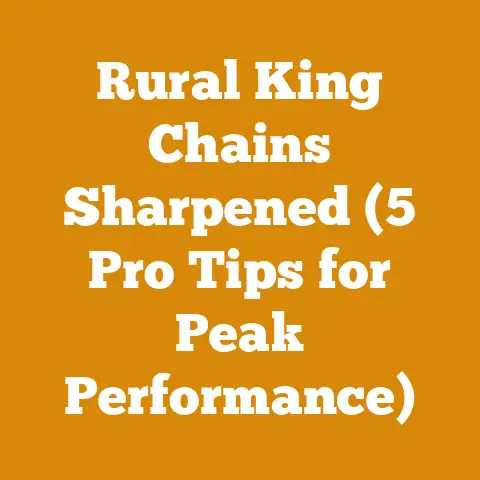What Causes Chainsaw to Cut Crooked? (5 Pro Sharpening Tips)
The reasons why a chainsaw cuts crooked have remained consistent throughout the ages, from the earliest lumberjacks to modern arborists. The principles of physics and mechanics haven’t changed, and neither has the frustration of battling a chainsaw that refuses to cut straight. Understanding these underlying causes and knowing how to address them is timeless knowledge, crucial for anyone who uses a chainsaw regularly.
What Causes Chainsaw to Cut Crooked? (5 Pro Sharpening Tips)
A chainsaw that cuts crooked can be incredibly frustrating and even dangerous. Instead of a clean, straight cut, you end up with uneven surfaces, wasted wood, and increased physical strain. There are several reasons why this happens, but the good news is that most of them are preventable with proper maintenance and technique. In this article, I’ll delve into the common causes of crooked cuts and provide five pro sharpening tips to help you get back on track.
Understanding the Problem: Why Chainsaws Cut Crooked
Before diving into sharpening tips, it’s important to understand the root causes of a crooked cut. This knowledge will help you diagnose the problem accurately and apply the right solution.
-
Unevenly Sharpened Chain: This is the most common culprit. If the teeth on one side of the chain are sharper or longer than the teeth on the other side, the chain will naturally pull towards the sharper side.
-
Damaged or Missing Teeth: A damaged or missing tooth on one side of the chain will disrupt the balance and cause the saw to cut unevenly.
-
Incorrect Depth Gauge Settings: The depth gauges (also known as rakers) control how much of the tooth engages with the wood. If they are not set correctly, the chain will not cut efficiently and can cause it to pull to one side.
-
Worn Guide Bar: A worn guide bar, especially if it’s worn unevenly, can cause the chain to bind or wander, leading to a crooked cut.
-
Improper Cutting Technique: Even with a perfectly sharpened chain, poor technique can lead to crooked cuts. This includes applying too much pressure, twisting the saw, or not maintaining a consistent cutting angle.
Project Metrics and KPIs in Wood Processing
Before we jump into the pro tips, let’s talk about project metrics. Why are they important? Because in the world of wood processing, logging tools, and firewood preparation, precision, efficiency, and cost-effectiveness are key. Tracking metrics helps you understand where you’re excelling, where you’re falling short, and how to improve your overall operation. It’s not just about getting the job done; it’s about getting it done right.
I remember a time when I was working on a large firewood preparation project. We were processing several cords of mixed hardwoods, and initially, we were just going through the motions, cutting and splitting without paying much attention to the numbers. It wasn’t until we started tracking metrics like wood volume yield, time per cord, and chainsaw downtime that we realized how much efficiency we were losing. We identified bottlenecks, adjusted our processes, and significantly improved our output. That experience taught me the invaluable lesson of data-driven decision-making in wood processing.
Let’s explore some key metrics and KPIs to help you monitor and improve your wood processing projects:
-
Wood Volume Yield (WV Yield)
- Definition: The ratio of usable wood volume obtained from a given volume of raw logs or trees. This is typically expressed as a percentage.
- Why It’s Important: WV Yield directly impacts profitability. A higher yield means less waste and more saleable product.
- How to Interpret It: A low WV Yield indicates inefficiencies in your cutting, splitting, or processing methods. Consider factors like log quality, saw kerf, and splitting techniques.
- How It Relates to Other Metrics: WV Yield is closely related to Wood Waste Percentage and Time per Cord. If you’re rushing and making sloppy cuts, your WV Yield will suffer.
-
Wood Waste Percentage (WW%)
- Definition: The percentage of raw wood material that is unusable and discarded during processing (e.g., sawdust, bark, misshapen pieces).
- Why It’s Important: Reducing wood waste saves money on raw materials and minimizes environmental impact.
- How to Interpret It: High WW% suggests inefficiencies in your cutting patterns, equipment maintenance, or log selection.
- How It Relates to Other Metrics: Closely linked to WV Yield; a high WW% directly results in a lower WV Yield. Also related to Chainsaw Downtime if poor maintenance leads to more waste.
-
Time per Cord (TPC)
- Definition: The amount of time (in hours or minutes) required to process one cord of wood from raw logs to finished firewood.
- Why It’s Important: TPC determines your labor costs and overall production capacity.
- How to Interpret It: A high TPC indicates potential bottlenecks in your workflow, inefficient equipment, or inadequate manpower.
- How It Relates to Other Metrics: TPC is inversely related to WV Yield. Speeding up the process may lead to lower yield and increased waste. It’s also related to Equipment Downtime; more downtime means a higher TPC.
-
Equipment Downtime (EDT)
- Definition: The amount of time equipment (chainsaws, splitters, etc.) is out of service due to maintenance, repairs, or breakdowns.
- Why It’s Important: EDT directly impacts production capacity and increases labor costs.
- How to Interpret It: High EDT indicates potential issues with equipment maintenance, operator skill, or the quality of the equipment itself.
- How It Relates to Other Metrics: High EDT leads to a higher TPC and potentially lower WV Yield if you’re forced to use less efficient equipment as a backup.
-
Chainsaw Chain Sharpening Frequency (CSF)
- Definition: The number of times a chainsaw chain needs to be sharpened per cord of wood processed or per hour of use.
- Why It’s Important: CSF indicates the efficiency of your sharpening technique, the type of wood you’re cutting, and the overall condition of your chain.
- How to Interpret It: A high CSF suggests that you may be encountering dirty wood, running your chain too hard, or not sharpening it correctly.
- How It Relates to Other Metrics: A high CSF can lead to increased EDT as you spend more time sharpening. It can also impact TPC if you’re constantly stopping to sharpen.
-
Moisture Content Level (MCL)
- Definition: The percentage of water content in the firewood.
- Why It’s Important: MCL determines the burn quality and heat output of the firewood. Properly seasoned firewood with low MCL burns cleaner and more efficiently.
- How to Interpret It: High MCL (above 20%) indicates that the wood needs more time to dry. Burning unseasoned wood can lead to creosote buildup and reduced heating efficiency.
- How It Relates to Other Metrics: MCL is related to Time per Cord because seasoning requires time. It also affects customer satisfaction and repeat business.
-
Cost per Cord (CPC)
- Definition: The total cost (including labor, materials, equipment, and overhead) required to produce one cord of firewood.
- Why It’s Important: CPC determines your profitability and helps you price your firewood competitively.
- How to Interpret It: High CPC indicates that you need to find ways to reduce costs, improve efficiency, or increase your selling price.
- How It Relates to Other Metrics: CPC is influenced by all the other metrics, including TPC, EDT, WV Yield, and fuel consumption.
-
Fuel Consumption Rate (FCR)
- Definition: The amount of fuel (gasoline or bar oil) consumed per cord of wood processed or per hour of chainsaw operation.
- Why It’s Important: FCR directly impacts your operating costs and environmental footprint.
- How to Interpret It: A high FCR suggests that your chainsaw may be running inefficiently, your chain may be dull, or you may be using the wrong type of fuel or oil.
- How It Relates to Other Metrics: FCR is related to Chainsaw Chain Sharpening Frequency (CSF) and Equipment Downtime (EDT). A dull chain or a poorly maintained chainsaw will consume more fuel.
-
Bar Oil Consumption Rate (BOCR)
- Definition: The amount of bar oil used per cord of wood processed or per hour of chainsaw operation.
- Why It’s Important: Adequate bar oil lubrication is crucial for preventing wear and tear on the chain and guide bar.
- How to Interpret It: A low BOCR could indicate that the oiler is malfunctioning or that you’re not using enough oil, leading to premature wear. A high BOCR could indicate a leak or excessive oiling.
- How It Relates to Other Metrics: BOCR is directly related to the lifespan of your chain and guide bar. Insufficient lubrication can lead to increased EDT and higher replacement costs.
-
Number of Cuts Per Chain (NCPC)
- Definition: The average number of cuts you can make with a chainsaw chain before it needs to be sharpened. This can be measured by the number of logs cut or the total length of wood cut.
- Why It’s Important: NCPC reflects the quality of your sharpening technique, the type of wood you’re cutting, and the overall condition of your chain.
- How to Interpret It: A low NCPC suggests that your chain is dulling quickly, possibly due to hitting dirt or rocks, or that your sharpening technique needs improvement.
- How It Relates to Other Metrics: NCPC is inversely related to Chainsaw Chain Sharpening Frequency (CSF). A higher NCPC means you need to sharpen less frequently.
By tracking these metrics, you can gain valuable insights into your wood processing operation and identify areas for improvement. Remember to keep accurate records and analyze the data regularly to make informed decisions.
5 Pro Sharpening Tips for Straight Cuts
Now, let’s get back to the issue of crooked cuts. Here are five pro sharpening tips to help you keep your chainsaw cutting straight:
-
Use a Consistent Sharpening Angle and Depth:
- The Key: Consistency is paramount. Use a chainsaw sharpening guide to maintain the correct sharpening angle (typically 25-35 degrees) and depth. This ensures that all teeth are sharpened identically.
- Why It Works: Consistent sharpening creates a balanced cutting action. Each tooth will bite into the wood with the same force, preventing the chain from pulling to one side.
- How to Do It: Invest in a good quality chainsaw sharpening kit that includes a filing guide. Follow the manufacturer’s instructions carefully. Pay close attention to the angle markings on the guide and ensure that you’re applying consistent pressure with each stroke.
- My Experience: I’ve found that using a depth gauge tool in conjunction with the filing guide makes a huge difference. It ensures that the depth gauges are set correctly, which is crucial for efficient cutting.
-
Sharpen All Teeth to the Same Length:
- The Key: Uneven tooth lengths are a major cause of crooked cuts. Shorter teeth on one side will result in a weaker cutting action on that side.
- Why It Works: Equal tooth lengths ensure that each tooth contributes equally to the cutting process, maintaining a balanced force.
- How to Do It: After sharpening each tooth, visually inspect it to ensure that it’s the same length as the others. You can also use a caliper to measure the tooth lengths for greater accuracy. If you find any teeth that are significantly shorter, you may need to replace the chain.
- My Experience: I once had a chain that kept cutting crooked despite my best efforts. After close inspection, I discovered that one tooth was significantly shorter than the others due to hitting a rock. Replacing the chain immediately solved the problem.
-
Maintain Proper Depth Gauge Settings:
- The Key: The depth gauges (rakers) control how much the teeth bite into the wood. If they are too high, the chain won’t cut efficiently. If they are too low, the chain will be too aggressive and can cause kickback.
- Why It Works: Correct depth gauge settings ensure that the teeth are cutting at the optimal depth, maximizing efficiency and preventing the chain from binding or wandering.
- How to Do It: Use a depth gauge tool to check the height of the depth gauges. File them down as needed, using a flat file and a depth gauge jointer. The recommended depth gauge setting varies depending on the type of wood you’re cutting, but a good starting point is 0.025 inches below the top of the cutting teeth.
- My Experience: I neglected to check the depth gauges on my chain for a long time, and I noticed that my saw was cutting very slowly and requiring a lot of force. After filing the depth gauges down to the correct setting, the saw cut like new again.
-
Clean and Inspect Your Guide Bar Regularly:
- The Key: A clean and well-maintained guide bar is essential for smooth and accurate cutting. Debris buildup and wear can cause the chain to bind or wander.
- Why It Works: A clean guide bar allows the chain to move freely and prevents friction, ensuring a straight and efficient cut.
- How to Do It: Regularly clean the guide bar with a wire brush to remove sawdust and debris. Check the bar rails for wear and burrs. If the rails are worn unevenly, you can use a guide bar dresser to restore them to their original shape. Also, make sure the oiler hole is clear and unobstructed.
- My Experience: I’ve found that flipping the guide bar periodically helps to distribute wear evenly and prolong its lifespan. It’s a simple but effective way to keep your saw cutting straight.
-
Practice Proper Cutting Technique:
- The Key: Even with a perfectly sharpened chain, poor technique can lead to crooked cuts. Avoid applying too much pressure, twisting the saw, or cutting at an angle.
- Why It Works: Proper technique ensures that the chain is cutting along a straight line, minimizing the risk of binding or wandering.
- How to Do It: Let the saw do the work. Apply gentle, consistent pressure and maintain a straight cutting angle. Avoid twisting the saw or forcing it through the wood. Use a felling wedge to prevent the wood from pinching the bar.
- My Experience: I used to struggle with crooked cuts when felling trees, especially when the wood was under tension. I learned to use a felling wedge to keep the cut open and prevent the bar from getting pinched, which significantly improved my accuracy.
Case Study: Improving Firewood Production Efficiency
Let’s look at a real-world example of how tracking metrics and applying these sharpening tips can improve firewood production efficiency.
Project: Small-scale firewood operation preparing 10 cords of mixed hardwoods (oak, maple, birch).
Initial Situation:
- Time per Cord (TPC): 6 hours
- Wood Waste Percentage (WW%): 15%
- Chainsaw Chain Sharpening Frequency (CSF): Every 2 cords
- Observed: Crooked cuts were common, leading to wasted wood and increased labor.
Intervention:
- Sharpening Education: The operator received training on proper chainsaw sharpening techniques, focusing on consistent angles, equal tooth lengths, and correct depth gauge settings.
- Equipment Maintenance: The chainsaw was thoroughly inspected and tuned up. The guide bar was cleaned and dressed.
- Technique Improvement: The operator focused on using proper cutting techniques, avoiding excessive pressure, and maintaining a straight cutting angle.
- Metric Tracking: The operator began tracking TPC, WW%, and CSF using a simple spreadsheet.
Results After 10 Cords:
- Time per Cord (TPC): Reduced to 4.5 hours (25% improvement)
- Wood Waste Percentage (WW%): Reduced to 8% (47% improvement)
- Chainsaw Chain Sharpening Frequency (CSF): Increased to every 3.5 cords (75% improvement)
- Observed: Crooked cuts were significantly reduced, resulting in less wasted wood and faster processing times.
Analysis:
The improvements in TPC, WW%, and CSF demonstrate the significant impact of proper sharpening and technique. By focusing on these key areas, the operator was able to reduce waste, increase efficiency, and improve the overall profitability of the firewood operation.
Challenges Faced by Small-Scale Loggers and Firewood Suppliers
I understand that many of you reading this are small-scale loggers or firewood suppliers, and you face unique challenges. You may not have access to the latest equipment or the same level of training as larger operations. You may be working with limited resources and tight budgets.
Here are some common challenges and how to address them:
- Limited Budget for Equipment: Invest in quality sharpening tools that will last. A good sharpening kit is more cost-effective in the long run than constantly replacing chains.
- Lack of Training: Take advantage of online resources, workshops, or mentorship opportunities to improve your sharpening and cutting skills.
- Time Constraints: Prioritize preventative maintenance to avoid costly downtime. A few minutes spent sharpening your chain or cleaning your guide bar can save you hours of frustration later.
- Variable Wood Quality: Adjust your sharpening technique and cutting speed based on the type of wood you’re cutting. Hardwoods require sharper chains and slower cutting speeds than softwoods.
- Remote Locations: Carry essential tools and spare parts with you in the field. Being prepared for common repairs can prevent costly delays.
Applying Metrics to Future Projects
The key to continuous improvement is to consistently track your metrics and use the data to inform your decisions. Here’s how to apply these metrics to future wood processing or firewood preparation projects:
-
Set Goals: Before starting a project, set realistic goals for each metric. For example, aim to reduce your TPC by 10% or increase your WV Yield by 5%.
-
Track Progress: Regularly monitor your progress and compare it to your goals. Use a spreadsheet or a notebook to record your data.
-
Identify Trends: Look for patterns in your data. Are you consistently struggling with a particular metric? Are there certain factors that seem to be affecting your performance?
-
Make Adjustments: Based on your analysis, make adjustments to your processes, equipment, or techniques. For example, if you’re consistently experiencing high EDT, you may need to improve your maintenance schedule or invest in more reliable equipment.
-
Repeat the Cycle: Continue tracking your metrics and making adjustments as needed. Over time, you’ll develop a deep understanding of your operation and be able to optimize your performance.
By embracing a data-driven approach, you can transform your wood processing or firewood preparation operation into a more efficient, profitable, and sustainable business. Remember, it’s not just about cutting wood; it’s about cutting it smarter.
Final Thoughts
Mastering chainsaw sharpening is a skill that pays dividends in terms of efficiency, safety, and the quality of your work. By understanding the causes of crooked cuts and applying these five pro sharpening tips, you can keep your chainsaw cutting straight and make your wood processing projects more enjoyable and productive. And by tracking key metrics, you can gain valuable insights into your operation and make data-driven decisions that will lead to continuous improvement. Happy cutting!






